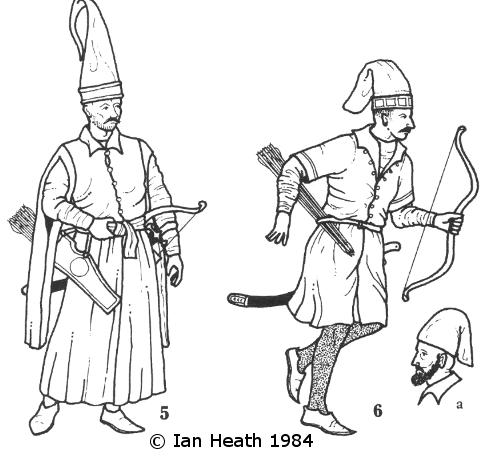JANISSARIES, 15th CENTURY
An extract from Armies of the Middle Ages, Volume 2by Ian Heath
 |
|
| [Based on A Turkish Janissary, c. 1480, by Gentile Bellini.] | [c.f. Khusrau Parviz and Bahram Chubina fight a second time, 1501] |
 |
|
| [Based on A Turkish Janissary, c. 1480, by Gentile Bellini.] | [c.f. Khusrau Parviz and Bahram Chubina fight a second time, 1501] |
5 & 6. JANISSARIES, 15th CENTURY
The most recognisable feature of the Janissary was undoubtedly his hat, which is commented on by just about every contemporary source, Western and Ottoman alike. It was called an ak börk by the Turks, and a mitra or pileus by 15th century Latin writers, while Doukas tells us that ‘in the common language of the Romans’ (i.e., vulgar Greek) it was called a zerkulah, which, being a corruption of zir kulah (a mail coif, later with a shallow dish covering the top of the head) would tend to imply that a mail hood or helmet was perhaps worn beneath it (see also note to figure 8). Doukas describes the hat as ‘made of the whitest felt, cylindrical in shape, snugly fitting the head, being as much as a span above the crown, and tapering to a point’, a description which tallies remarkably well with the hat worn by figure 5, from a drawing made in Constantinople in 1479 by Gentile Bellini, possibly of a Solak guardsman. However, the origin of this white hat predates the establishment of the Janissaries. Uruj, a 15th century chronicler drawing on 14th century material, says it was adopted c.1340 on the suggestion of Orkhan’s brother, ’Ali Pasha, who advised him to make all his army wear red hats except for his ‘dependent slaves’ (i.e., the Qapu Khalqi), who should wear instead a white hat. Idris al-Bitlisi, on the other hand, has it that the whole of Orkhan’s army wore white caps, but that under Bayezid I it was ordained on the advice of Timurtash Bey that only the sultan’s personal troops should wear white hats, while the rest were to wear red. (Karamanli Turks too are recorded wearing red caps in the 14th century.) All the sources agree that the ’azabs and other Turkish soldiers (‘both commoners and nobles’, says Doukas) were thereafter distinguished from the Janissaries by wearing red hats such as can be seen in figures 3, 4, 7 and 10, 11, 12 & 13. Other late-15th century pictures show Janissaries wearing instead the more characteristic sleeve-cap that is to be seen in 16th century pictures, which would seem to confirm the likelihood that the hat which Doukas described, and which was worn by the Janissary Bellini drew, was actually that of a Solak. Figure 6, from a Persian ms. of the 1470s or 1480s, and 6a, from the Zonchio woodcut, both depict such sleeve-caps.
In addition to their hats, the Janissaries appear to have been identifiable by the fact that, probably along with other elements of the Qapu Khalqi, they were uniformed. It seems from Idris al-Bitlisi’s chronicle that uniforms were first introduced under Bayezid I who, we are told, ‘chose various garments for his army’, the uniforms then introduced (of gold-embroidered silk according to Cantacuzene) seemingly lasting until the 1440s when, according to Pseudo-Sphrantzes, Murad II changed them. Our only clue to the colour of the new uniform that he introduced is to be found in the ‘Ordo Portae’ of c.1473-81, which tells us that every year each Janissary received lengths of linen and blue cloth, plus a shirt and a woollen kaftan. (Konstantin Mihailovic similarly states that each Janissary received a kaftan, a shirt, and ‘large trousers made, as is their fashion, of 3 ells of cloth, and a shirt of 8 ells’, but alas, he does not mention colours.) The ms. from which 6 comes, depicting Janissaries in action without the kaftan worn by 5 (which could be tucked up as described under figure 3), shows their tunics coloured blue, red and green all colours recorded for Janissary uniforms in the 16th century with red trousers and undershirts in a variety of colours. The rims of their zerkulahs are shown gilt, written sources similarly describing the rim as silver or gilt. The Zonchio woodcut shows Janissaries only in red and green kaftans (the only colours other than brown that its artist used).
However uniformly they may have been dressed, this uniformity did not extend to the Janissaries’ armament. It would appear that they selected their own weapons. The ‘Ordo Portae’ says: ‘They are armed, therefore, each to his liking, and each takes whatever arms he sees.’ The majority, however, were bow-armed prior to the introduction of handguns (see next figure), and remained so until the end of this era, each Janissary receiving 30 aspen annually for the purchase of a bow and arrows. In his description of the Janissaries, Mihailovic states that ‘some are archers who shoot bows, some are gunners who shoot mortars, others handguns, and still others crossbows’. A similar list of arms is provided by Lascaris, who wrote that the ‘greater part’ of the Janissaries were armed with ‘only bows and swords’, others having bucklers, assorted spears and polearms, and some handguns and crossbows, to which can be added maces, daggers, axes and javelins (djerid). The Janissaries were certainly using handguns by the mid-15th century at the latest, one contemporary referring to 650 arquebusiers and 50 gunpowder-makers among them at about that time. Certainly the first census of the Ottoman garrison of Serbian Novo Brdo in 1455 included 10 Janissary handgunners. There was a marked increase in the use of firearms amongst the Janissaries following several reverses suffered at the hands of the Mamluks in 1485-91.